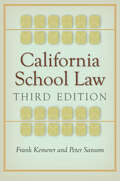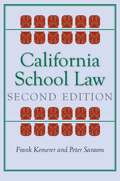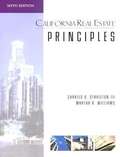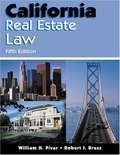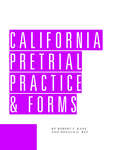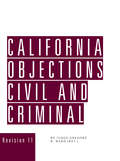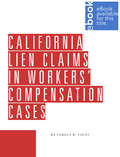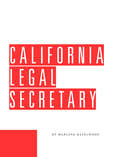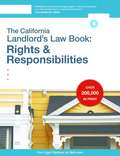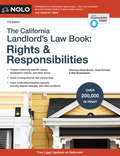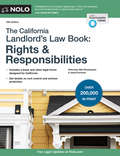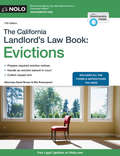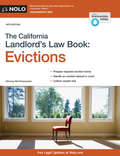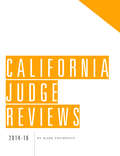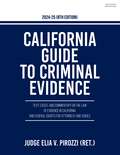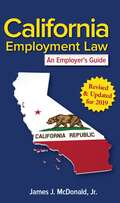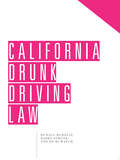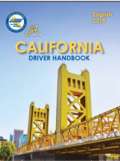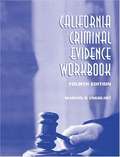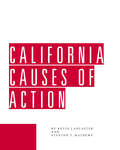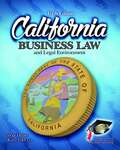- Table View
- List View
California School Law: Third Edition
by Frank Kemerer Peter SansomNow in its third edition, California School Law is the only comprehensive source discussing how federal and state law affects the day-to-day operation of the state's traditional public, charter, and private schools. While the book is comprehensive, the authors have written it for a broad audience. California School Law has become a coveted desk-top reference for administrators, governing board members, school attorneys, union leaders, and policymakers. It also has been widely adopted as a classroom textbook in educational administration and education law classes. The first chapter provides an explanation of the legal framework within which California schooling takes place and key players at the state, district, and school level. Ensuing chapters examine student attendance and truancy, curriculum law, employment law, teacher and student rights of expression, the school and religion, students with disabilities, student discipline, privacy and search and seizure, and legal liability in both state and federal court. Also included are chapters on unions and collective bargaining, educational finance issues, and racial and gender discrimination. Appendices provide a glossary of legal terminology, an explanation of how to find and read legislative enactments and judicial decisions, and a list of sources for accessing law. The book's table of contents is included on this website. Law never stands still. To keep the book current, the authors will maintain a cumulative update for the third edition on this website, beginning in January 2014.
California School Law
by Frank Kemerer Peter SansomA comprehensive discussion of how law affects the day-to-day operations of California's public, charter, and private schools, written for policy makers, governing board members, school administrators, union leaders. teachers, students and practitioners and education law, and parents. The reference explains the legal framework in which schooling takes place, and examines constitutional, statutory, and judicial law governing attendance and instruction, school accountability, school finance, collective bargaining, employment, free speech, religion, the delivery of services to children with disabilities, student discipline, open meetings and records, privacy and student search and seizure, race and gender discrimination and harassment, and legal liability. The three authors are attorneys who teach and specialize in education law. Annotation ©2004 Book News, Inc. , Portland, OR (booknews. com)
California Real Estate Principles (7th edition)
by Charles O. Stapleton Martha R. WilliamsCombining the latest state specific information with solid industry fundamentals, this user-friendly text gives students a strong foundation for a career in real estate. California Real Estate Principles comes loading with instructor resources and extra features to enhance the student-learning experience and make teaching the class easier than ever.
California Real Estate Law, 5th ed.
by William Pivar Robert BrussKnown for its accessible approach to real estate law and comprehensive state specific information, this introductory text is a favorite with California Broker candidates.
California Pretrial Practice & Forms
by Donald G. Rez Robert F. KaneCalifornia Pretrial Practice & Forms probes every step of civil procedure before trial. Authors Robert F. Kane and Donald G. Rez share their wisdom and documents in this sophisticated and affordable guide, with an issue-oriented outline format supported by over 6,000 recent cases, 200 forms, case-based illustrations, practice-proven strategies, step-by-step procedures, and pattern language. Coverage runs from taking the case up to trial, and includes numerous tips on how to: * Avoid and fix mistakes * Resolve peripheral disputes * Craft better documents * Answer ethical questions * Process cases efficiently * Sharpen your responses This book focuses on the areas where questions and disputes frequently arise, and devotes pages to where you spend time: drafting pleadings, preparing and presenting motions, conducting discovery, resolving discovery disputes, and negotiating settlements. California Pretrial Practice & Forms probes every step of civil procedure before trial. Authors Robert F. Kane and Donald G. Rez share their wisdom and documents in this sophisticated and affordable guide, with an issue-oriented outline format supported by over 6,000 recent cases, 200 forms, case-based illustrations, practice-proven strategies, step-by-step procedures, and pattern language. Coverage runs from taking the case up to trial, and includes numerous tips on how to: * Avoid and fix mistakes * Resolve peripheral disputes * Craft better documents * Answer ethical questions * Process cases efficiently * Sharpen your responses This book focuses on the areas where questions and disputes frequently arise, and devotes pages to where you spend time: drafting pleadings, preparing and presenting motions, conducting discovery, resolving discovery disputes, and negotiating settlements.
California Objections
by Gregory H. WardThe key to winning evidentiary debates is objecting and responding with arguments and supporting authority at your fingertips. Most evidentiary rulings are within the judge's discretion, and are made in seconds. Bad rulings are almost never reversible. As a result, victory usually goes to the lawyer who can prevail on the big objections in the heat of battle. Whether you are in the courtroom or preparing for trial, California Objections will help you use the rules of evidence to your client's advantage. Judges Gregory Ward and Michael Byrne (Ret.) masterfully detail: * 125 objections with pattern objection language * scope of governing rules * practice tips and cautions with detailed advice from the bench * arguments for making and responding to objections * over 1,800 recent cases The key to winning evidentiary debates is objecting and responding with arguments and supporting authority at your fingertips. Most evidentiary rulings are within the judge's discretion, and are made in seconds. Bad rulings are almost never reversible. As a result, victory usually goes to the lawyer who can prevail on the big objections in the heat of battle. Whether you are in the courtroom or preparing for trial, California Objections will help you use the rules of evidence to your client's advantage. Judges Gregory Ward and Michael Byrne (Ret.) masterfully detail: * 125 objections with pattern objection language * scope of governing rules * practice tips and cautions with detailed advice from the bench * arguments for making and responding to objections * over 1,800 recent cases The key to winning evidentiary debates is objecting and responding with arguments and supporting authority at your fingertips. Most evidentiary rulings are within the judge's discretion, and are made in seconds. Bad rulings are almost never reversible. As a result, victory usually goes to the lawyer who can prevail on the big objections in the heat of battle. Whether you are in the courtroom or preparing for trial, California Objections will help you use the rules of evidence to your client's advantage. Judges Gregory Ward and Michael Byrne (Ret.) masterfully detail: * 125 objections with pattern objection language * scope of governing rules * practice tips and cautions with detailed advice from the bench * arguments for making and responding to objections * over 1,800 recent cases The key to winning evidentiary debates is objecting and responding with arguments and supporting authority at your fingertips. Most evidentiary rulings are within the judge's discretion, and are made in seconds. Bad rulings are almost never reversible. As a result, victory usually goes to the lawyer who can prevail on the big objections in the heat of battle. Whether you are in the courtroom or preparing for trial, California Objections will help you use the rules of evidence to your client's advantage. Judges Gregory Ward and Michael Byrne (Ret.) masterfully detail: * 125 objections with pattern objection language * scope of governing rules * practice tips and cautions with detailed advice from the bench * arguments for making and responding to objections * over 1,800 recent cases The key to winning evidentiary debates is objecting and responding with arguments and supporting authority at your fingertips. Most evidentiary rulings are within the judge's discretion, and are made in seconds. Bad rulings are almost never reversible. As a result, victory usually goes to the lawyer who can prevail on the big objections in the heat of battle. Whether you are in the courtroom or preparing for trial, California Objections will help you use the rules of evidence to your client's advantage. Judges Gregory Ward and Michael Byrne (Ret.) masterfully detail: * 125 objections with pattern objection language * scope of governing rules * practice tips and cautions with detailed advice from the bench * arguments for making and responding to objections * over 1,800 recent cases
California Lien Claims in Workers' Compensation Cases
by Pamela W. FoustLien claim law and procedure have grown so complex that procedural error and faulty reasoning can affect outcomes more than the merits. Pitfalls abound and missteps can be costly. Now you can readily learn the law and arguments that support your position with California Lien Claims in Workers' Compensation Cases. Judge Pamela Foust's plain English guide walks you step-by-step through the law and procedure of lien claims. California Lien Claims in Workers' Compensation Cases delivers: * Solutions to problems you are likely to encounter * Recommended arguments, with supporting authority * All judicial, administrative, and legislative developments * Practice tips, strategies, and cautions from the bench * Custom-drafted and WCAB forms to improve your documents In addition to her practice materials, Judge Foust provides analysis and determinations for dozens of hypothetical fact patterns. These resolutions may be used to predict outcomes and to persuade reluctant clients and adversaries. Basic facts and multiple variations are included for: * Admitted injury * Disputed injury * Cumulative trauma * Reasonable value * Penalties * Attorney's fees
California Legal Secretary
by Marlene HazlewoodFiling procedures are seldom found in traditional practice guides, forms CD-ROMs, or on the web. Colleagues with experience in the area may be unavailable. Court clerks are hard to reach. When you need ready and reliable answers to procedure questions, turn to Marlene Hazlewood's California Legal Secretary. Written specifically for those who have to quickly prepare and file legal documents, this helpful resource contains: * Concise statements of procedure in quick-reading outline format * Explanation of legal terms of art * Detailed completion and filing instructions, including step-by-step checklists that walk you through every procedure * Over 200 model forms in both print and CD for the most common types of litigation and transactions Speed up and simplify your court filings and transactions with this affordable guide.
California Landlord's Lawbook, The: Rights & Responsibilities
by David Brown Attorney Ralph Warner Attorney Janet Portman AttorneyEvery California landlord and residential property manager needs The California Landlord's Law Book: Rights & Responsibilities. For over 25 years, the definitive guide for landlords in the Golden State has clearly and comprehensively covered everything you need to know about: security deposits leases and rental agreements property managers habitability liability lead paint discrimination rent control terminations and evictions and much more This edition includes up-to-date information on landlord-tenant laws, including new California requirements that landlords provide tenants with details on how and where rent is to be paid before terminating for nonpayment of rent, and new language on notice of entry and termination forms regarding tenant rights as to abandoned property. Plus you get access to a unique web page on nolo.com where you can instantly download more than 40 forms, including a lease and rental agreement, tailored to meet California law. Check out Every Landlord's Legal Guide.
California Landlord's Law Book, The: Rights & Responsibilities
by Janet Portman David Brown Nils Rosenquest AttorneyFor over 30 years, The California Landlord’s Law Book has been guiding landlords safely and efficiently through the maze of regulations that affect them, and keeping them profitable and out of legal hot water. Choosing tenants, raising the rent, and returning deposits--these are just a few of the things landlords do that are strictly regulated by law in California. Here, you will find all the easy-to-understand information you need to minimize legal risk, including a California-specific lease and rental agreement and more than 40 forms with complete instructions. You'll learn how to: screen prospective tenants - without discriminating illegally prepare (and enforce) leases and rental agreements collect and return security deposits so as to avoid lawsuits raise the rent and change other terms of the tenancy hire, work with, and fire a property manager keep up with repairs and maintenance limit liability and rent withholding follow state privacy laws on entering rental units restrict tenants from subletting or hosting short-term guests act promptly when rent is late terminate a tenancy, ...and much more.
California Landlord's Law Book, The: Rights & Responsabilities
by Janet Portman Nils RosenquestThe legal information and forms every California landlord needs Choosing tenants, raising the rent, returning deposits, and maintaining rental property—these are just a few of the things landlords do that are strictly regulated by California law. To avoid problems and hefty legal fees, rental property owners and managers need to know and comply with federal, state, and local rules, and use the proper legal forms. Fortunately, everything you need is in this book. For more than 30 years, The California Landlord’s Law Book: Rights & Responsibilities has been the leading source of legal information for hundreds of thousands of California landlords. This edition has been completely updated to cover state and federal laws and local rent control ordinances. It includes dozens of California-specific forms, such as leases and rental agreements, all with complete, easy-to-follow instructions tailored to state law. You’ll learn how to: screen prospective tenants - without discriminating illegally prepare (and enforce) leases and rental agreements collect and return security deposits raise the rent and change other terms of the tenancy hire, work with, and fire a property manager keep up with repairs and maintenance restrict tenants from subletting or hosting short-term guests act promptly when rent is late, and terminate a tenancy. All forms are downloadable through a special link in the book .
California Landlord's Law Book, The: Evictions
by David Brown Nils RosenquestReady to evict a problem tenant? Use the definitive step-by-step guide to evictions in California. Sooner or later, every landlord is faced with handling an eviction. Don't get caught spending thousands on attorneys fees when The California Landlord's Law Book: Evictions will guide you through the process every step of the way -- without breaking the bank. Read up on the different legal grounds for eviction in plain English, plus get all the forms and step-by-step instructions needed to perform a successful and legal eviction. Learn how to: prepare and serve nonpayment of rent notices prepare and serve 30-, 60- or 90- day notices file an unlawful detainer complaint in court win by default if the tenant doesn't respond handle a contested case represent yourself in court deal with eviction-delaying tactics, and collect the unpaid rent after you win. Still the only step-by-step guide through the California eviction process, this edition reflects current law and provides the latest information, forms, and instructions for a quick and legal eviction.
California Landlord's Law Book, The: Evictions
by David Brown AttorneyReady to evict a problem tenant? Use the definitive step-by-step guide to evictions in California Sooner or later, every landlord is faced with handling an eviction. Don't get caught spending thousands on attorney's fees when The California Landlord's Law Book: Evictions will guide you through the process every step of the way -- without breaking the bank. Read up on the different legal grounds for eviction in plain English, plus get all the forms and step-by-step instructions needed to perform a successful and legal eviction. Learn how to: prepare and serve 3-, 30-, 60- or 90-day notices file an unlawful detainer complaint in court win by default if the tenant doesn't respond handle a contested case represent yourself in court deal with eviction-delaying tactics collect the unpaid rent after you win Still the only step-by-step guide through the California eviction process, this edition reflects current law and provides the latest information, forms, and instructions for a quick and legal eviction. Check out Nolo's list of California products.
California Landlord's Law Book, The: Evictions
by Nils RosenquestYour step-by-step guide to evicting a problem tenant in California Sooner or later, nearly every residential landlord has to evict a tenant for nonpayment of rent, property damage, an illegal sublet (including Airbnb), or another violation of the lease or the law. You don’t always need to hire a lawyer, but you do need reliable information, particularly if your property is under rent control. Here, you’ll find all of the forms you need along with clear, step-by-step instructions on how to: prepare nonpayment of rent notices prepare 3-, 30-, 60-, and 90-day notices complete and serve all required eviction forms deal with tenants’ delaying tactics, and file your “unlawful detainer” complaint in court. Just filing an eviction lawsuit may prompt the tenant to leave. If it doesn’t, you’ll learn how to: handle a contested eviction suit by yourself—and know when to get professional help respond to a tenant’s defenses and claims evict a tenant who has filed for bankruptcy or is occupying property you purchased at a foreclosure sale, and collect unpaid rent after you win. All forms are downloadable through a special link in the book.
California Judge Reviews (California Courts & Judges)
by Mark Thompson Elizabeth SmithCalifornia Courts & Judges has been renamed California Judge Reviews, and the guide's contents have been streamlined and restructured to emphasize attorney comments about California judges. California Judge Reviews includes candid and frank attorney comments, compiled through interviews conducted by authors Elizabeth Smith and Mark Thompson, for several hundred superior court and district court judges and commissioners. This publication includes more than 2,500 detailed biographies of state and federal judges in California. It provides biographical information on many state and some federal judges in California and attorneys' comments about most L.A. and S.F. civil judges. The book also includes a comprehensive, statewide court directory and information about associations and ADR organizations. Preparation is the key to winning, and that preparation includes knowing your judge. Be completely ready for your next court appearance with the latest 2-volume California Courts & Judges' detailed biographies, which include information such as: Pre-bench background Political affiliation Appointment dates Appointing official Association membership Education Legal authorship Age Business address Personal interests Judicial philosophy Availability as arbitrator
California Guide to Criminal Evidence 2024-25 (8th edition): Text, Cases, and Commentary on the Law of Evidence in California and Federal Courts for Attorneys and Judges
by Elia V. PirozziThis treatise is used by attorneys and judges throughout California as a comprehensive resource on evidentiary and constitutional issues. It is unique in its approach with numerous checklists, courtroom scripts and easy-reference charts.
California Employment Law: The Complete Survival Guide to Doing Business in California
by Douglas J. FarmerThe most comprehensive and easy-to-read reference on the market today. Now used by thousands of human resources executives, in-house counsel, business owners and employment lawyers across the United States, this comprehensive guide addresses the latest legal rules and best practices to avoid liability in the California workplace. Comes complete with the latest California forms, checklists and compliance tools. For recent changes to the law, go to www.EmploymentLawPublishers.com for free legal updates between editions.
California Employment Law: An Employer's Guide
by James McDonaldWritten especially for HR professionals and business people, California Employment Law: An Employer's Guide is the essential resource for avoiding the many perils and pitfalls California employers face. Comprehensively updated to address new developments, the 2019 Edition features: New independent contractor test New harassment training requirements Class-action waivers in arbitration agreements New rules on national origin discrimination Requirement that employees be paid for minimal preparation and concluding work Clarification of rules regarding salary history inquiries New NLRB standards for employee conduct policies Requirements for lawful time clock rounding Rules for rest break pay for commissioned and piece-rate employees ?New rules regarding lactation breaks
California Drunk Driving Law
by Ed Kuwatch Barry Simons Paul BurglinCalifornia Drunk Driving Defense has long been referred to as "the bible of DUI defense," and for good reason. This two-volume treatise remains indispensable for both newer attorneys seeking fundamental information about such things as charges, sentencing, and license suspension actions, and veteran attorneys looking for more detailed analysis on scientific issues, trial tips, and writs and appeals. Most attorneys do not realize how many solid DUI defenses exist, and so plead instead of fight their cases. The enormous complexity of California DUI law has created painful traps for the unwary, so wise guidance is essential. California Drunk Driving Law is the number one book in its field. From arrest to punishment, and additional charges to DMV hearings, this practical work overflows with cutting-edge tactics, analysis, and tools for mounting a successful defense. The book is chock-full of: * Creative defenses. Hundreds of decision-based arguments, generated by the authors in their decades of creative DUI practice and collected from successful DUI practitioners statewide, bring real leverage to your plea bargaining, trials, and DMV proceedings. * Heavily supported motions. Crafted, tested, and polished by top DUI lawyers, these practice-proven documents will materially raise the level of your advocacy. The book has over 120 forms that can be accessed digitally and modified to your case. * Answers and solutions. 95% of the questions that arise in day-to-day DUI practice are addressed. References to other sources are provided for the other 5%. * Authoritative interpretation of the law. Over 1,700 cases and every relevant statute and regulation are analyzed and cited. For answers to all your client's questions (and yours), turn to California Drunk Driving Law. This invaluable book provides the most complete coverage of state DUI practice available.
California Driver Handbook 2018
by State of California Department of Motor VehiclesCalifornians drive more than 350 billion miles a year – more than any other state. We want to make that ride as safe, sustainable and efficient as possible. Please do your part by carefully studying this California Driver Handbook and practice safe driving habits. Together, we can improve California’s roadways.
California Driver Handbook
by Department of Motor VehiclesThis California Driver Handbook promotes practicing safe driving habits among the public to improve California's roadways.
California Criminal Law Workbook
by Richard F. McGrath Doug HaynesCalifornia Criminal Law Workbook Seventh Edition
California Criminal Evidence Workbook
by Marvin G. EngquistThe purpose of this Workbook is to provide the student with an outline for notes on the basic elements of criminal evidence. When taken to each class, this workbook will provide the student with the opportunity and space to write information related to various parts of this subject. The source for this information is the Evidence Code, your instructor, and the appropriate textbook assigned for this course. Your instructor will describe, illustrate, and explain the information on which your notes should be based. Should you have any difficulty in deciding which notes to write, ask your instructor for additional information. The information that you write will help you understand the material presented as well as assist you in preparation for quizzes, examinations, term projects, or case briefs which may be assigned.
California Causes of Action
by Kevin Lancaster Stanton T. MathewsNo longer will you have to sift through opinion after opinion to find one that recites all the elements of a cause of action. California Causes of Action delivers both the elements and the supporting decisions, plus affirmative defenses, related causes of action, remedies, and statutes of limitations. This useful resource will help you draft pleadings, conduct discovery, marshal evidence, prepare jury instructions, make and respond to motions, and prepare appellate briefs for over 155 causes of action in 21 practice categories, including: * Negligence * Emotional Distress * Physical Torts * Fraud and Negligent Misrepresentation * And more! California Causes of Action helps you avoid the cost, hassle, and risk of a demurrer by providing clear explanations of each element and annotated case notes. Drafting an answer or a cross complaint is also a breeze. With the detailed affirmative defenses for each cause of action, you'll never second-guess the strength of your response again. Write with ease and confidence; write with California Causes of Action.
California Business: Law and Legal Environment
by Kim Tyler Walter Roy Huber William McGrathPublished in 2018, this newest edition of California Business Law has undergone major C-ID renovations, including the title. It is now the 5th edition of California Business Law (Legal Environment of Business). <p><p>There is a reason for this change, that includes among other things a mandate from the Community College Chancellor’s Office (Senate) regulating the material necessary to include in a Business Law or Legal Environment of Business book in order to qualify it for transfer to the Cal-State or UC System. They have adopted a “universal” C-ID numbering system of 120 (Business Law) and 125 (Legal Environment). Although not all community colleges use this numbering system, they are required to adhere to the topics enumerated in the list.
